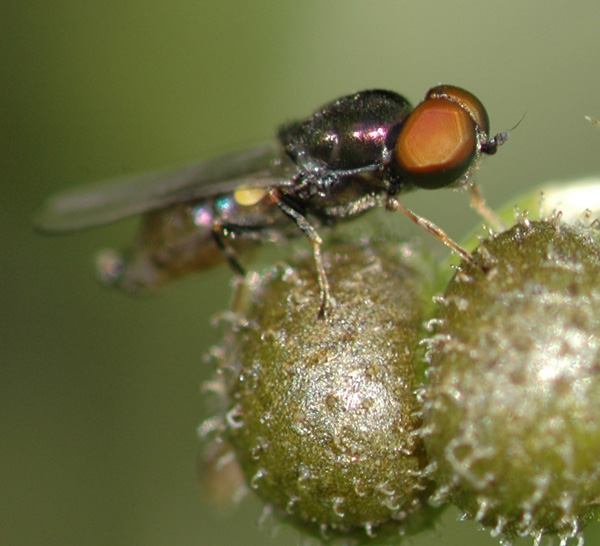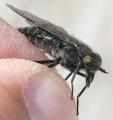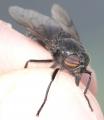Diptera.info :: Identification queries :: Diptera (adults)
Who is here? 1 guest(s)
|
Microchrysa cyaneiventris ?
|
|
| Pierre55 |
Posted on 02-01-2008 20:36
|
|
Member Location: Belgium (Héron) Posts: 150 Joined: 11.08.07 |
Pic taken on 07.07.2007 in Belgium Really little fly. Thanks for your help 
Pierre55 attached the following image:  [130.92Kb] Edited by Pierre55 on 03-01-2008 12:53 Pierre OGER 4217 H?ron (BELGIUM) |
|
|
|
| jorgemotalmeida |
Posted on 02-01-2008 20:38
|
|
Member Location: Viseu - PORTUGAL Posts: 9296 Joined: 05.06.06 |
I'd say stratiomyid? |
| Paul Beuk |
Posted on 02-01-2008 20:43
|
|
Super Administrator Location: Netherlands Posts: 19403 Joined: 11.05.04 |
Microchrysa cyaneiventris?
Paul - - - - Paul Beuk on https://diptera.info |
| Pierre55 |
Posted on 02-01-2008 21:02
|
|
Member Location: Belgium (Héron) Posts: 150 Joined: 11.08.07 |
Many thanks Jorge and Paul for the proposal 
Pierre OGER 4217 H?ron (BELGIUM) |
|
|
|
| Andre |
Posted on 02-01-2008 21:12
|
|
Member Location: Tilburg, the Netherlands Posts: 2111 Joined: 18.07.04 |
Microchrysa cyaneiventris male, is the only candidate, I agree. |
| Pierre55 |
Posted on 02-01-2008 21:18
|
|
Member Location: Belgium (Héron) Posts: 150 Joined: 11.08.07 |
Thx again, Andre, for the confirmation 
Pierre OGER 4217 H?ron (BELGIUM) |
|
|
|
| David Gibbs |
Posted on 03-01-2008 10:45
|
|
Member Location: Bristol, UK Posts: 833 Joined: 17.06.06 |
"Resembling M. polita but differing in the following respects.........Antennae yellowish-brown, the last 1-2 flagellomeres and arista darkened" (Roskosny 1982 pp 128). The insect in the photo seems to have all dark antennae suggesting polita. is Rozkosny wrong and cyaneiventris can have black antennae? all my British specimens have reddish antennae. |
|
|
|
| Paul Beuk |
Posted on 03-01-2008 11:07
|
|
Super Administrator Location: Netherlands Posts: 19403 Joined: 11.05.04 |
I was (and am) not entirely certain about cyaneiventris but that mainly had to do with the much reduced shine of the mesonotum...
Paul - - - - Paul Beuk on https://diptera.info |
| Andre |
Posted on 03-01-2008 14:37
|
|
Member Location: Tilburg, the Netherlands Posts: 2111 Joined: 18.07.04 |
I agree with Paul, about the reduced shine (not looking greenish at all) on the mesonotum. To my idea the yellow on the first two segments is there, but hardly visible due to flash maybe. This yellow can be faint. |
| David Gibbs |
Posted on 03-01-2008 16:02
|
|
Member Location: Bristol, UK Posts: 833 Joined: 17.06.06 |
i can see how flash can eliminate the irridesence on metallic insects (see example in gallery of polita, just as black as this one) but can flash photography really turn yellow antennae into black antennae? perhaps GB specimens are different but cyaneiventris here have very obviously yellow antennae. also my specimens show very little difference in the green gloss on the thorax, it is the abdomen which is black in cyaneiventris, and my cyaneiventris have largely yellow tibia (one male confirmed by dissection), mostly black in polita. Incidently, in Rozkosny's key males are distinguished on male genitalia  |
|
|
|
| kitenet |
Posted on 03-01-2008 17:21
|
|
Member Location: Buckinghamshire, UK Posts: 118 Joined: 04.05.06 |
For what it is worth, my specimens of Microchrysa agree with David's description of antennal and leg colours, making me think Pierre's photo is M. polita  Martin Martin Harvey |
| Andre |
Posted on 03-01-2008 17:59
|
|
Member Location: Tilburg, the Netherlands Posts: 2111 Joined: 18.07.04 |
David has a point or two in favor of polita, I must agree. To me the angle to the first two segments is too difficult to make out if these are yellowish or not. A view from the top would help, would it  . Polita is the most seen species of the three, that's a fact. . Polita is the most seen species of the three, that's a fact. How about the third species, flavicornis in the UK?. This species has really yellow antennae (so up to third segment) and very yellow legs too. And it has the thoracic shine of polita. I have seen many cyaneiventris from malaisetraps, none has "obviously" yellow 3rd antennal segments. Do you have another pic for us? With or without flash, maybe it can help us out? Edited by Andre on 03-01-2008 18:17 |
| David Gibbs |
Posted on 03-01-2008 18:46
|
|
Member Location: Bristol, UK Posts: 833 Joined: 17.06.06 |
Andre wrote:How about the third species, flavicornis in the UK?. Andre, i did consider that i had misidentified my specimens and that they are all really flavicornis, which is why i mentioned that one was dissected, it fits the illustration in Rozkosny (Plate 24 figs 1-3) so assuming Rozkosny's illustrations are correctly labeled, i think my specimens are correctly named. all my cyaneiventris have black abdomen whereas flavicornis have glossy green abdomen concolourous with thorax. Extent of yellow on antennae very similar between the two species. |
|
|
|
| Paul Beuk |
Posted on 03-01-2008 19:55
|
|
Super Administrator Location: Netherlands Posts: 19403 Joined: 11.05.04 |
David Gibbs wrote: i can see how flash can eliminate the irridesence on metallic insects (see example in gallery of polita, just as black as this one) but can flash photography really turn yellow antennae into black antennae? I did not realise that the flash could kill the metallic shine on Microchrysa. In that case I immediately change my opinion to polita because the metallic shine on the abdomen, darkish antennae and the absence of a yellow lateral mesonotal line. Paul - - - - Paul Beuk on https://diptera.info |
| Jump to Forum: |













